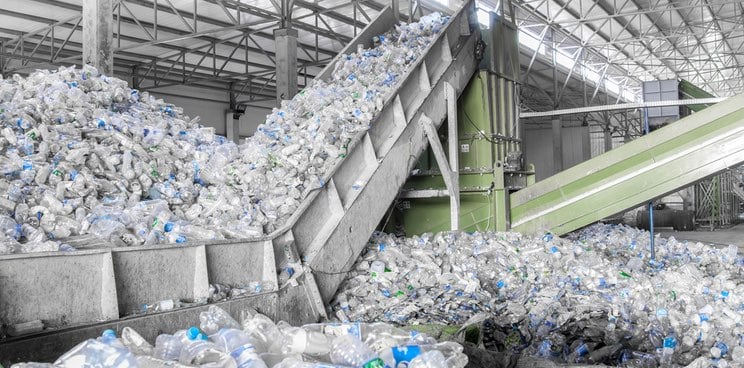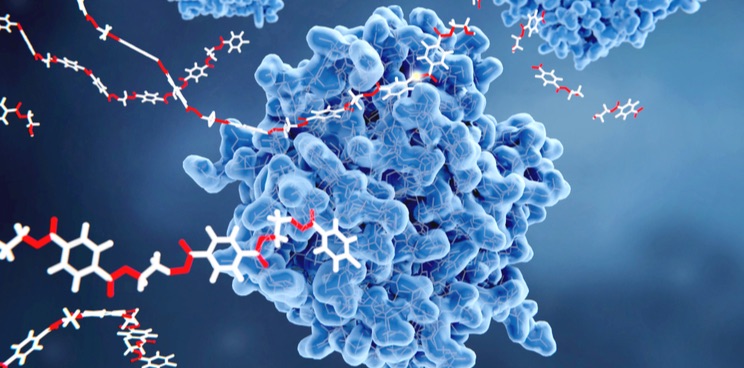Newsletter Signup - Under Article / In Page
"*" indicates required fields
A new type of enzyme developed by the French company Carbios can break down more than 90% of the plastic PET, commonly used to make plastic bottles, and the byproducts can then be recycled into new PET. But how far does this go towards solving our plastic waste problem?
PET, or polyethylene terephthalate, comprises around 7% of the plastic we use today and is the fifth most commonly used plastic. It is used for a variety of purposes, but a common application is food packaging and plastic drinks bottles.
Although a lot of biodegradable plastics fall into the ‘polyester’ group, PET is quite difficult to break down. Enzymes that can break down PET have existed for a while, but were previously very inefficient.
As reported in the journal Nature, French researchers based in Toulouse and at the bioplastics biotech company Carbios have produced a new enzyme that is capable of breaking down more than 90% of PET in 10 hours. It outperforms all previously described enzymes with similar capabilities.
Carbios is working with Danish industrial biotech giant Novozymes to help scale up production of the enzyme.
Alain Marty, Carbios CSO and co-author on the paper, cautions that the technology is still at an early pilot phase, adding that “Carbios has launched the construction of an industrial demonstration plant that will use this enzymatic depolymerization process from the beginning of 2021 to recycle post-consumer PET plastics and polyester fibers.”
A big problem with PET is that the current main recycling methods destroy some of the properties of the plastic and it is difficult to produce a recycled product with the same mechanical qualities as the original ‘virgin’ product.
“In order to maintain the standard mechanical properties of a plastic bottle, for example, recycled PET is blended with the virgin PET, perpetuating the need for the virgin polymer and reliance on the petrochemical industry,” explained Dragana Dobrijevic, a researcher at University College London’s Plastic Waste Innovation Hub, who was not involved in the current research.
However, Marty and co-authors found that the breakdown products produced using the new enzyme could be used to produce PET with the same properties as newly produced plastic.
“This development is a major step towards a circular economy of PET, because, contrary to the commonly used thermomechanical recycling processes, our enzymatic alternative enables the use of all PET waste,” co-author of the paper Sophie Duquesne, a researcher from the Toulouse Biotechnology Institute, told me. “This means less plastic going to landfill or incineration, and the saving of fossil fuel resources.”

Although this research is undoubtedly a step in the right direction, there is still a long way to go before it can be useful on a wider scale. To begin with, PET is only the fifth most commonly used plastic and there are no enzymatic degradation methods currently available for the top four.
Irina Borodina, a senior scientist at the Novo Nordisk Foundation Center for Biosustainability in Denmark, who was not involved in the research, believes it may be possible to engineer enzymes that could break down other forms of plastic in the future.
As to whether the new enzyme can be used to clean up PET-based rubbish, it seems we may have to wait a while for this. “It can be used on the sorted, colored fraction of PET waste and implementation will depend on the economy of the process,” Borodina emphasized.
“For cleaning up mixed plastic waste, such as present in landfills or oceans, we first need to find enzymes that degrade the other most common plastic types, such as polyethylene and polypropylene.”
The circular economy idea aims to minimize waste and pollution, keep materials in use and regenerate and rebuild natural systems. It is something a lot of people believe we should work towards including many scientists and biotech companies that are trying to promote and increase sustainable practices.
Although technologies such as Carbios’s PET-degrading enzymes can help us be more sustainable, it is not the only requirement for a circular economy to work on a larger scale.
“The main reason why we don’t have a circular economy is not because we don’t have the technologies, but because there is no political will to make a change, for example through introducing carbon tax,” Borodina told me.
“Scientists have already created sustainable technologies for making jet fuel, biodegradable plastics, and most of the other chemicals and materials we need from renewable feedstocks, such as biomass. But these novel technologies cannot compete with the petrochemical industry that pumps oil and gas from the ground for free without any consideration for the environmental, health, and climate influences.”
Images from Shutterstock
Partnering 2030: FME Industries Report







